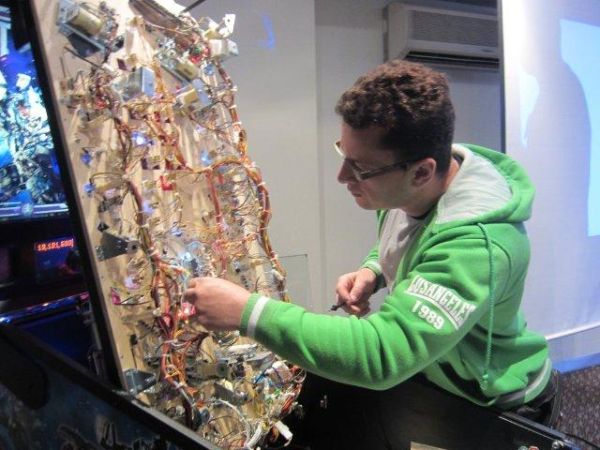Start the Ball Rolling
When you first approach a modern pinball machine, you are met with an intricate weaving of electronic and mechanical parts, all designed to create a game in which you are challenged to score points without losing the ball or tilting the game.
The main components of the game are the flippers and the pinball. The flippers are usually located at the bottom of the playfield, directly above the drain. One purpose of the flippers is to keep the pinball out of the drain. The other purpose is to propel the ball up the table toward the bumpers and ramps in order to score points — occasionally, extra flippers are placed farther up on the table for this purpose. The flippers are controlled with two buttons, one on either side of the machine, about an inch below the table’s top glass. The left button controls any and all flippers on the left side of the table, and the right button controls the ones on the right side.
A pinball is a 1 1/16 inch diameter (about 3 cm) steel sphere that weighs 2.8 ounces (80 g). On a normal (unwaxed) table, the ball can reach speeds of up to 90 miles per hour (145 kph). With this traditional steel pinball, the ball’s magnetic properties sometimes come into play, as some machines use magnets to trap the ball in certain places on the playfield. In a few machines, a ceramic pinball called a powerball is used. This ball weighs only 2.28 ounces (65 g), so it moves faster around the table and is immune to the magnets used on some games.
The pinball flies around the table, hitting bumpers and targets to score points — at least that’s what you want to happen. Otherwise, the ball falls down the drain and you move on to your next ball. You only get three. When your third ball goes down the drain, your game is over, unless you’ve played well enough to score a replay, or been lucky enough to get a match. We’ll learn about these special circumstances later. First, let’s look at how the pinball machine is put together.
The Backbox
The backbox portion of the table serves two purposes: to hold the main electronics of the game and to attract players with a decorative piece of art located on the backglass. The electromechanical bumpers and flippers found on the table are all tied into the main controller board located behind the backglass. Located on this board, like on a computer motherboard, is a ROM chip that contains all the information needed to play the game.
The wiring that runs from the controller board to the rest of the machine is massive, usually consisting of over a half-mile (0.8 km) of wire. These wires carry commands back and forth between the main board and the flippers, bumpers, targets and ramps.
There are usually two other pieces of electronics contained in the backbox. A dot-matrix display board, usually either 128×32 or 192×64 pixels in dimension, is located at the base of the backglass. This display is used to relay information to the player, such as the score and hints about how to increase the score and possibly get a free game. Also, since the early 1990s, a speaker has been located on either side of the dot-matrix display. Pinball sounds are now digital and have grown to include full musical scores to accompany game play.
The backbox also has a second purpose: to attract players. The backglass art is carefully crafted to draw the player to a certain machine over any other in the arcade. Usually done by a professional artist, some original backglass paintings have been sold to collectors for thousands of dollars. Along with the art, the dot-matrix display is also used to attract players. Elaborate animations are created to run on the display in conjunction with the theme of the machine.
For more detail: How Pinball Machines Work

